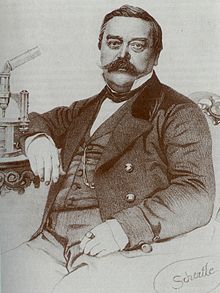Theodor Hartig
Theodor Hartig | |
|---|---|
 Theodor Hartig, from the book Biographien bedeutender hessischer Forstleute, Wiesbaden und Frankfurt am Main 1990, p. 271 | |
| Born | 21 February 1805 |
| Died | 26 March 1880 (aged 75) |
| Nationality | German |
| Known for | Sieve tube elements, Hartig net |
| Scientific career | |
| Fields | Forestry science, botany, zoology |
| Author abbrev. (botany) | Hartig |
| Author abbrev. (zoology) | Hartig |
Theodor Hartig (21 February 1805 – 26 March 1880) was a German forestry biologist and botanist.
Biography
Hartig was born in Dillenburg. He was educated in Berlin (1824–1827), and was successively lecturer and professor of forestry at the University of Berlin (1831–1838) and at the Carolinum, Braunschweig.[1]
Hartig was the first to discover and name the sieve tube element cells (as Siebfasern - sieve fibres and Siebröhren - sieve tubes) in 1837. His zoologist author abbreviation is Hartig. He described many gall wasp species.
In 1842, Theodor Hartig described what is now known as the Hartig net, a network of fungal hyphae that penetrate feeder roots and surround epidermal cells.[2][3] The Hartig net is part of the structure of ectomycorrizae, mutualistic symbioses between fungi and plant roots.
He died in Braunschweig.
Works
- 1836. Forstliches und forstnaturwissenschaftliches Conversations-Lexicon. Georg Ludwig Hartig and Theodor Hartig
- 1840. Über die Familie der Gallwespen. Zeitschrift für die Entomologie, ed. von E.F. Germar, 2: 176–209
- 1841. Erster Nachtrag zur Naturgeschichte der Gallwespen. Zeitschrift für die Entomologie, ed. von E.F. Germar, 3: 322–358
- 1843. Zweiter Nachtrag zur Naturgeschichte der Gallwespen. Zeitschrift für die Entomologie, ed. von E.F. Germar, 4: 395–422
- 1851. Vergleichende Untersuchungen über den Ertrag der Rotbuche (2nd ed.)
- 1860. Die Aderflügler Deutschlands (2nd ed.)
- 1866. Forstwissenschaftliches Examinatorium den Waldbau betreffend
- 1877 Luft-, Boden- und Pflanzenkunde in ihrer Anwendung auf Forstwirtschaft und Gartenbau, bearbeitet von Theodor Hartig für alle Freunde und Pfleger der wissenschaftlicher Botanik
- 1878. Anatomie und physiologie der holzpflanzen. Dargestellt in der entstehungsweise und im entwickelungsverlaufe der einzelzelle, der zellsysteme, der pflanzenglieder und der gesammtpflanze
In collaboration with his father, Georg Ludwig Hartig, he published the work entitled, Forstliches und naturwissenschaftliches Konversationslexikon. The eleventh edition of his father's Lehrbuch für Förster, the later reprints of which he had revised, was published in 1877.
Family
He was the son of Georg Ludwig Hartig (1764–1837), a German forester. His son Robert (1839–1901) was a forest scientist and mycologist who is considered the "father of forest pathology".
References
- ^ One or more of the preceding sentences incorporates text from a publication now in the public domain: Gilman, D. C.; Peck, H. T.; Colby, F. M., eds. (1905). . New International Encyclopedia (1st ed.). New York: Dodd, Mead.
- ^ Money, Nicholas P (2011). Mushroom. Oxford: Oxford University Press. p. 71.
- ^ Maser, C; Claridge, A W; Trappe, J M (2008). Trees, Truffles, and Beasts: How Forests Function. New Brunswick: Rutgers University Press. p. 54.
- ^ International Plant Names Index. Hartig.
- Wikipedia articles incorporating a citation from the New International Encyclopedia
- Wikipedia articles incorporating text via vb from the New International Encyclopedia
- Wikipedia articles incorporating text from the New International Encyclopedia
- Articles with hCards
- Zoologists with author abbreviations
- Botanists with author abbreviations
- Articles with ISNI identifiers
- Articles with VIAF identifiers
- Articles with GND identifiers
- Articles with ICCU identifiers
- Articles with J9U identifiers
- Articles with KBR identifiers
- Articles with LCCN identifiers
- Articles with NTA identifiers
- Articles with PLWABN identifiers
- Articles with Botanist identifiers
- Articles with Leopoldina identifiers
- Articles with DSI identifiers
- Articles with DTBIO identifiers
- Articles with SNAC-ID identifiers
- Articles with SUDOC identifiers
- 1805 births
- 1880 deaths
- Academic staff of the Technical University of Braunschweig
- 19th-century German botanists
- German entomologists
- German foresters
- Humboldt University of Berlin alumni
- Academic staff of the Humboldt University of Berlin